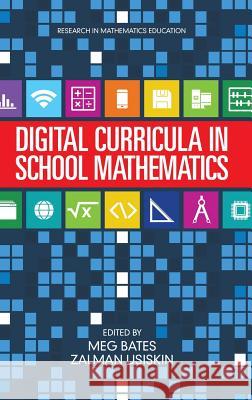Digital Curricula in School Mathematics (HC) » książka
Digital Curricula in School Mathematics (HC)
ISBN-13: 9781681234120 / Angielski / Twarda / 2016 / 336 str.
Digital Curricula in School Mathematics (HC)
ISBN-13: 9781681234120 / Angielski / Twarda / 2016 / 336 str.
(netto: 390,40 VAT: 5%)
Najniższa cena z 30 dni: 406,56
ok. 30 dni roboczych.
Darmowa dostawa!
A volume in Research in Mathematics Education Series Editors: Denisse R. Thompson, University of South Florida, Mary Ann Huntley, Cornell University, and Christine Suurtamm, University of Ottawa The mathematics curriculum - what mathematics is taught, to whom it is taught, and when it is taught - is the bedrock to understanding what mathematics students can, could, and should learn. Today's digital technology influences the mathematics curriculum in two quite different ways. One influence is on the delivery of mathematics through hardware such as desktops, laptops, and tablets. Another influence is on the doing of mathematics using software available on this hardware, but also available on the internet, calculators, or smart phones. These developments, rapidly increasing in their availability and decreasing in their cost, raise fundamental questions regarding a mathematics curriculum that has traditionally been focused on paper-and-pencil work and taught in many places as a set of rules to be practiced and learned. This volume presents the talks given at a conference held in 2014 at the University of Chicago, sponsored by the Center for the Study of Mathematics Curriculum. The speakers - experts from around the world and inside the USA - were asked to discuss one or more of the following topics: changes in the nature and creation of curricular materials available to students transformations in how students learn and how they demonstrate their learning rethinking the role of the teacher and how students and teachers interact within a classroom and across distances from each other The result is a set of articles that are interesting and captivating, and challenge us to examine how the learning of mathematics can and should be affected by today's technology."
A volume in Research in Mathematics EducationSeries Editors: Denisse R. Thompson, University of South Florida, Mary Ann Huntley, Cornell University, and Christine Suurtamm, University of OttawaThe mathematics curriculum - what mathematics is taught, to whom it is taught, and when it is taught - is the bedrock to understanding what mathematics students can, could, and should learn. Todays digital technology influences the mathematics curriculum in two quite different ways. One influence is on the delivery of mathematics through hardware such as desktops, laptops, and tablets. Another influence is on the doing of mathematics using software available on this hardware, but also available on the internet, calculators, or smart phones.These developments, rapidly increasing in their availability and decreasing in their cost, raise fundamental questions regarding a mathematics curriculum that has traditionally been focused on paper-and-pencil work and taught in many places as a set of rules to be practiced and learned.This volume presents the talks given at a conference held in 2014 at the University of Chicago, sponsored by the Center for the Study of Mathematics Curriculum. The speakers - experts from around the world and inside the USA - were asked to discuss one or more of the following topics:• changes in the nature and creation of curricular materials available to students• transformations in how students learn and how they demonstrate their learning• rethinking the role of the teacher and how students and teachers interact within a classroom and across distances from each otherThe result is a set of articles that are interesting and captivating, and challenge us to examine how the learning of mathematics can and should be affected by todays technology.











